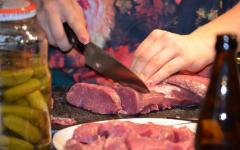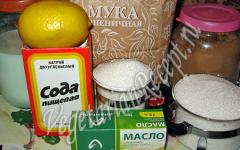January 28, 2016 17:30 Pianist Karina Ter-Ghazaryan, a second-grade student at the Gnessin Music School, performs Robert Schumann’s “Father Frost.” Young artists listen to her. Their task is to draw the images that arise in their minds when listening to
PHOTO: Anton GerdoThe Moscow authorities recognized the Children's Music School named after R.M. as an object of cultural heritage of regional significance. Gliere, which was built in 1906. A stone four-story building with basement premises and an attic superstructure is located at the address: Bolshaya Yakimanka Street, building 29.
The building was built in the historicist style, borrowing elements from English architecture - triangular pediments crowning the building and large windows doubled in some places.

The building of the Children's Music School is located at: Bolshaya Yakimanka Street, building 29
– The facade of the building from the side of Bolshaya Yakimanka is asymmetrical due to the protrusion - risalit, located next to the passage arch. The ledge itself ends in a small turret, and the windows of the second floor in this place are double,” explained the head of the Moscow Department of Cultural Heritage, Alexey Emelyanov.
He clarified that the attic floor was decorated with small multi-profile triangles with a frame. From the side of 2nd Khvostov Lane the facade is symmetrical: windows different sizes on different floors. There are small openings for windows on the ground and first floors, and spacious rectangular windows on the upper floors.

From the side of 2nd Khvostov Lane the facade is symmetrical: windows of different sizes on different floors
Initially, this building housed the Second Moscow City State School. The music school was located here in 1937. During the war years, training was suspended, but in 1944 classes began to be held within the walls of this building again. Among the teachers of the specialized institution were such famous personalities as: the teachers were artists of the orchestra of the Bolshoi Theater of the USSR, for example, trumpeter Ivan Vasilevsky and flautist Vladimir Tsybin. IN different time The following students also studied here: conductors Viktor Eliseev and Valery Khalilov, composers Mikhail Bronner and Sergei Dmitriev, singers Vyacheslav Dobrynin and Mikhail Shufutinsky.
In the early 80s, a museum class dedicated to the work of the Soviet composer Reinhold Gliere was opened at the music school, as noted on the official website of the mayor of Moscow. In 1988, the building was redeveloped on all floors except the third, where the assembly hall was located, designed by the architect of the building himself, Alexander Nikiforov.

The facade of the building from the side of Bolshaya Yakimanka is asymmetrical due to the protrusion - risalit, located next to the passage arch
According to Alexey Emelyanov, today the school building is under reconstruction. One of the staircases has been almost completely preserved to this day. The facades of the music school are hidden under a mesh, but their structure and decor have been preserved and will be put in order.
Previously, the capital authorities recognized the Children's Hospital named after St. Olga as an object of architectural heritage ().
The building is located on the historical territory of the Church of the Holy Apostles Peter and Paul, on Yakimanskaya Street. beyond the Moscow River. The church territory occupied the western part of the modern 423rd quarter.
In the second half of the 18th century. Along the northern border of the property, small plots of land are being isolated for rent.
In 1806, along the western border of one of the leased plots, on the site of the former parochial school, a stone, two-story public school with a residential semi-basement and mezzanine was built. The writer P. A. Buryshkin (author of the book “Merchant Moscow”) and the poet V. Lebedev-Kumach studied there.
Judging by the photograph from Naydenov’s Album of 1886, the development of the western border of the property formed a continuous front along the red line of the street. The stone tent at this time retained the features of late Moscow classicism, behind it the volume of the refectory and the church was visible, then the bell tower, behind which - wooden building almshouses and further - the building of the public school.
At the beginning of the 20th century. The Moscow educational district decided to erect a new stone building of the 2nd Moscow City State School, the project of which was completed in 1901–1902. architect A. A. Nikiforov. Construction works began later - in 1905, after all the old buildings were demolished, and ended in the summer of 1906.
The newly erected house “3-storey stone with a semi-basement and a fourth attic floor, with a drive-through gate” occupied most of the property and formed the corner of the block at the intersection of the street. Bolshaya Yakimanka and Maly Petropavlovsky (modern 2nd Khvostov) lane. The “L”-shaped volume in plan was placed along the boundaries of the courtyard, with the main facades along the adjusted red lines of the street and alley along the entire front of the site. Entrance to the courtyard, the space of which is from the western and north sides The wings of the new building were limited, and on the side of the church property, a stone fence was provided through the passage arch from the side of Bolshaya Yakimanka. Basements were built under part of the yard.
It is likely that the new building included fragments of the walls of the basement and first floor of the previously located buildings.
The configuration of the site determined the original layout of the building. It was dominated by three types of premises - classrooms connected according to the enfilade principle; teachers' rooms and utility rooms; an assembly hall occupying the entire third floor. The original planning structure was partially changed during major repairs held in Soviet time. The third floor has retained its function. The basement under the courtyard, used for economic purposes, has also been preserved.
In 1988, the planning structure on the first, second and fourth floors was built according to the corridor principle. Training facilities located on both sides. There is a wardrobe in the semi-basement. On the first and second floors, the cornices have been preserved, as well as the original flights of stairs and fencing.
The music school was created in 1933 in accordance with the resolution of the Presidium of the District Council dated September 20, 1933 and on the basis of the Order of the financial department of public education of the Leninsky district of Moscow. The first director of the school was Maria Mikhailovna Kovaleva. The school was taught by artists from the orchestra of the Bolshoi Theater of the USSR: trumpeter Ivan Antonovich Vasilevsky and flutist Vladimir Nikolaevich Tsybin (professor at the Moscow Conservatory in 1923–1949). At this time, Roman Efimovich Sapozhnikov worked at the school, who subsequently created a system for training aspiring cellists - the “School of Cello Playing”, many collections, anthologies of the school repertoire. Professors of the Moscow Conservatory - pianist Genrikh Gustavovich Neuhaus and violinist Abram Ilyich Yampolsky conducted consultations.
Samuil Borisovich Okser, author and co-author (together with V.N. Vladimirov) of textbooks on musical literature for music schools, which taught more than one generation of future musicians, worked at this school in the 1940s. He was also the author of the first program on musical literature compiled in our country.
The school has been located in the building in question since 1937. For many years, the school coexisted in the same building with the conducting and choral department of the Music and Pedagogical School named after. October revolution. Many teachers combined teaching at school and college: E. K. Kotova, I. M. Samoilovich, A. V. Mirer, L. I. Fikhtengolts, T. S. Bessmertnova and others.
During the Great Patriotic War The school was closed for some time, but already in 1944 it accepted the first students returning from evacuation.
In 1962, the school was assigned No. 7.
In 1982, a museum class dedicated to the work of R. M. Gliere was opened. Among the school's graduates are conductors Viktor Eliseev and Valery Khalilov, composers Mikhail Bronner and Sergei Dmitriev, popular singers Vyacheslav Dobrynin and Mikhail Shufutinsky, artists Elena Solovey and Pavel Smeyan, TV presenters, journalists, and teachers.
Since 1993, the school was named after R. M. Gliere.
The school was created in 1933 in accordance with the resolution of the Presidium of the District Council dated September 20, 1933 and on the basis of the Order of the financial department of public education of the Leninsky district of Moscow.
The founder is the Moscow Department of Culture.
The beginning was made in 1933 by the energy and will of Maria Mikhailovna Kovaleva, the first director of the school. A wonderful person and teacher, she was able to attract the best musicians, who through their joint efforts proved the viability of good initiatives in the musical education of children.
Artists of the orchestra of the Bolshoi Theater of the USSR came here to work: trumpeter Ivan Antonovich Vasilevsky and flutist Vladimir Nikolaevich Tsybin (professor at the Moscow Conservatory in 1923-1949).
From the first days of its existence, Roman Efimovich Sapozhnikov worked at the school - then still a graduate student at the Moscow Conservatory, and later a teacher who created a harmonious system for training a novice cellist - the “School of Cello Playing”, many collections, anthologies of the school repertoire. The creation of a creative atmosphere and high professionalism at the school was greatly influenced by outstanding musicians, professors of the Moscow Conservatory - pianist Genrikh Gustavovich Neuhaus and violinist Abram Ilyich Yampolsky, who worked with us as consultants.
Outstanding musicians began their teaching careers at our school: the Turkin sisters - Galina Andreevna and Yulia Andreevna, People's Artist of Russia organist Garry Yakovlevich Grodberg, Evgeniy Mikhailovich Timakin (one of Mikhail Pletnev's teachers), pianist Lydia Izrailevna Fikhtengolts.
In 1945, Olga Aleksandrovna Apraksina came to work at the school, while simultaneously working in the Moscow City music school and the Academy of Pedagogical Sciences. Subsequently, she became a Doctor of Pedagogical Sciences, deputy director of the Institute of Artistic Education of the Academy of Pedagogical Sciences of the RSFSR, and the author of several books and manuals on Russian music pedagogy.
Samuil Borisovich Okser, the author and co-author (together with V.N. Vladimirov) of textbooks on musical literature for music schools, from which more than one generation of future musicians studied, worked at our school in the 40s. He was also the author of the first program on musical literature compiled in our country.
In the first years, the school, which did not have its own premises, huddled in one of the classrooms secondary school Zamoskvorechye. The teachers were true enthusiasts; they conducted regular classes under difficult conditions. A clearly structured schedule made it possible to conduct classes in piano, various orchestral specialties, theoretical disciplines, choir and ensembles.
For many years, the school coexisted in the same building with the conducting and choral department of the Music and Pedagogical School named after. October revolution. Many teachers combined teaching at school and college: E.K. Kotova, I.M. Samoilovich, A.V. Mirer, L.I. Fichtengolts, T.S. Bessmertnova and others. These people gave our school their talent, love of music, coupled with work and high professionalism. The next generation of teachers, a large part of whom are former graduates, strengthens and develops the established traditions.
During the Great Patriotic War (1941-1945), the school was closed for some time, but already in 1944 it accepted the first students returning from evacuation. At that difficult time educational process began thanks to the first caretaker of the school, Praskovya Mikhailovna Demina, who preserved musical instruments, school equipment, and the building itself.
Since 1937, the school has never left the building in which it is now located. But she changed her name and “registration” more than once. At first it was called Children's Music School No. 1 of the Leninsky District of Moscow. Since 1960 - became Children's Music School No. 7 of the Kirovsky, then Oktyabrsky district. Finally, since 1993, the school began to bear the name of Reingold Moritsevich Gliere. Yakimanka Street, on which the school is located, was called Georgiy Dimitrov Street for a long time.
Pages musical life from different years are reflected on the stands of the School History museum, created for the 70th anniversary. A large fund of concert programs, posters, congratulatory addresses, souvenirs, and newspaper articles has accumulated. All these are exhibits of the museum, which are its decoration. Over the years, the number of materials has increased: there was no longer room for them on the stands, and albums appeared that reflected the history of the development of all departments existing at the school.
In 1982, a museum class dedicated to the work of R.M. was opened. Gliera.
Over 80 years, thousands of students received music education at the school. Graduates of the Gliere school become not only music lovers. Among them - famous people, constituting support and pride musical culture Russia: conductors Viktor Eliseev and Valery Khalilov, composers Mikhail Bronner and Sergei Dmitriev, popular singers Vyacheslav Dobrynin and Mikhail Shufutinsky, artists Elena Solovey and Pavel Smeyan, TV presenters, journalists, teachers.
All of its directors, starting from the first director, Maria Mikhailovna Kovaleva, made a great contribution to the development of the school.
For 40 years the school was led by a school graduate (graduated in 1941), an honored cultural worker Russian Federation, Shegal Alexander Abramovich.
For 15 years, the school was also led by its graduate (graduated in 1970), an honorary cultural worker of the city of Moscow, Olga Petrovna Alekseeva.
All school principals
1933-1948
Kovaleva Maria Mikhailovna
Kulkova V.I.
Kovaleva Maria Mikhailovna
1948-1950
Tipikin Alexander Nikolaevich
Lipkin Lev Efimovich
1951-1952
Turilkin S.G.
Skvortsov V.N.
1953-1955
Toluzakova Maria Pavlovna
Kuchevskaya E.A.
1955-1958
Plyaskov Yan Mikhailovich
1958-1959
Grinchenko Margarita Yurievna
1960-1962
Lychany Friedrich Isidorovich
1962-2001
Shegal Alexander Abramovich
2001-2016
Alekseeva Olga Petrovna
2016 - present
Steinhauer Arnold Leopoldovich









